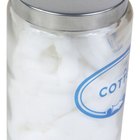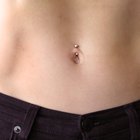
Sometimes, people obtain piercings impulsively and then quickly regret them. If you have a piercing that you no longer want, it may or may not close easily, depending on where the piercing is located and how long you have had the piercing. Tongue piercings, for instance, close more easily and quickly than other bodily piercings, such as ear piercings, since the tongue is a muscle. You may or may not be able to fully close a piercing on your own without having to surgically correct the skin, but there are ways to shrink the hole and reduce scarring.
Remove the piercing only after it has fully healed from the initial puncture. You may think the hole will close more quickly the sooner you take it out, and this is somewhat true; however infections are more likely to develop in the wound if open, and infections can cause permanent scarring and damage to the skin. Remove the piercing after all signs of redness, puss and irritation are gone.
Wash piercings every day, before and after removing jewelry, with mild soap and warm water. Wash in the morning and at night to remove residue, dirt and puss that accumulate in and around the piercing. Thoroughly rinse the piercing with water after applying soap, as soap scum can gather in the hole. Pat dry with a towel, rather than allow the piercing to air dry.
Apply an anti-scarring gel to the piercing daily for at least 30 days, unless the gel causes a reaction, such as irritation or inflammation of the skin. Use gel on external piercings only. Avoid using on a tongue or lip piercing, as ingredients are not safe for consumption.
Eat a nutritious diet, take a multivitamin and drink the recommended six to eight glasses of water per day. Hydration and a vitamin-rich diet help skin to rejuvenate and repair itself.
Related Articles

How to Clean Nose Rings

How to Drain a Cheek Piercing

How to Clean Smiley Piercings

How to Care for a Rook Piercing

How to Remove a Labret Piercing

How to Remove a Captive Navel Ring

How to Remove a Belly-Button Ring

How to Keep a Piercing From Rejecting

How Long Should I Wait to Get My Nose ...
How Long Should I Wait to Change My ...

How Long Before a Nose Ring Hole Closes?

How to Pierce Your Navel

Complications of Nipple Piercing

How to Remove a Navel Piercing

Homemade Recipe to Disinfect a Piercing

How to Get Rid of a Bump on Your Nose ...

Facts on Nose Piercings

Reactions to Nose Piercings

How to Tell If Your Nose Piercing Closed

How to Wear a Nose Hoop
References
Writer Bio
Audrey Farley began writing professionally in 2007. She has been featured in various issues of "The Mountain Echo" and "The Messenger." Farley has a Bachelor of Arts in English from the University of Richmond and a Master of Arts in English literature from Virginia Commonwealth University. She teaches English composition at a community college.
Photo Credits
Photos.com/Photos.com/Getty Images